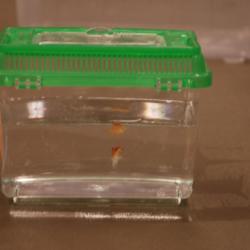Source Institutions
Source Institutions
Add to list Go to activity
Activity link broken? See if it's at the internet archive

In this activity, learners observe live fish in tanks to consider how their body structures are related to their behaviors and habitats. The activity is written for use in an aquarium, but it can work with any fish tank. Sets of facilitation questions are provided to help encourage the learner to make observations and generalizations. Some background information is provided about fish and their adaptations, which can be grouped into categories such as size, shape of body and tail, coloration patterns, location of mouth, and size of teeth.
- 30 to 45 minutes
- 10 to 30 minutes
- $5 - $10 per group of students
- Ages 4 - adult
- Activity
- English
Quick Guide
Materials List (per group of students)
- 1 transparent tank per fish species. This activity seems to work best with at least 5-7 species. Try to get fish with a variety of mouth, body, and tail shapes if possible. (If you have a large aquarium exhibit to set up in front of, you may still want small tanks so that visitors can begin with a focused observation -– this is especially useful for younger visitors.)
- If you are doing this activity in front of a large tank, provide pictures of the fish in the tank you are observing for sorting purposes (especially for younger learners)
- Laminated pictures of other fish with a variety of tail, body and mouth shapes as well as coloration patterns
- A table that allows all fish species to be viewed simultaneously
- Color photographs of the habitats for each of the fish species you choose
- Appropriate food for each species
- Paper, crayons or markers, and possibly clipboards
- Optional: Fish wheel materials (See separate activity -- Fish Wheels)
Subjects
-
Life Sciences
-
Diversity of Life
- Animals
-
Evolution
- Evidence for Evolution
-
Diversity of Life
-
The Nature of Science
-
The Scientific Process
- Asking Questions
- Formulating Explanations
-
The Scientific Process
Informal Categories
- Animals
Audience
To use this activity, learners need to:
- see
- see color
- touch
Learning styles supported:
- Involves hands-on or lab activities
Other
Includes alignment to state and/or national standards:
This resource is part of:
Access Rights:
- Free access
By:
Rights:
- All rights reserved, Regents of the University of California, Berkeley, 2009
Funding Source:
- National Science Foundation, NSF OCE-0731338
